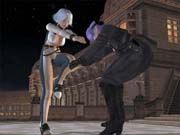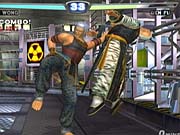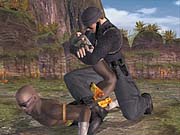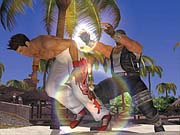Dead or Alive 3 Preview
We have an 80 percent-complete version of Tecmo's shiny new fighter.

Without a doubt, Dead or Alive 3 is one of the Xbox's most anticipated upcoming releases. The third installment in Team Ninja's acclaimed fighting series ups the ante in various ways, though mainly in regard to graphics--the fighting system has been virtually unchanged, outside of Team Ninja's addition of some new moves here and there. Still, those of you into DOA's open, free-flowing combo system, the deft counter mechanics, and the bombshell character designs are in for a treat to be sure.
The version we've received is 80 percent complete, which has allowed us to play through all of the game's basic modes. The missing 20 percent will presumably comprise the game's hidden extras--new costumes for the basic characters and perhaps new play modes, arenas, and the like. Tecmo has revealed nothing regarding the unlockables at this point, so to speculate further would be useless. The game has a good deal of stuff available out of the box, though, so the pain wasn't too great. In terms of modes, nine are available at the outset: story, time-attack, survival, tag-team, team battle, versus, watch (to view CPU battles), and sparring (a full-featured practice mode). All of them are fairly self-explanatory and basically requisite as far as fighters are concerned. The sparring mode is especially useful, as you have the option of going through any given character's move list and practicing each individual attack. Sadly, our version didn't include sample combos in the roster, like what Namco is known to implement into its practice modes. Still, given the relatively open-ended nature of the game's combo system, it isn't such a huge issue.

The character roster is especially hearty. All the fighters from DOA 2 return (though Ein is back as Hayate, his original, ninja-master identity), along with a couple of additions. The total count is a respectable 16. The additions, as already well documented, are Christie, the silver-haired British assassin in the black-and-white spandex; Hitomi, the scrappy German high-school student/kung fu master; and Brad Wong, the young Chinese practitioner of the drunken fist style. Each of the new characters is pleasantly distinctive--Christie fights in the distinct snake style, with an emphasis on swift, cutting punch combos, while Hitomi deals mostly in powerful, flailing kicks. Brad's swaying, powerful technique, finally, is highly characteristic of his Zui Ba Xion Quan style. Certain moves of his are executed while he leisurely lays prone, head on arm, including a brutal set of trip moves.
Each of the new characters seems to mesh very well with the flowing, encouraging Dead or Alive fighting system. Players new to it should find the system pretty easy to get started with, while veterans will definitely enjoy the effects that the refined animation system has added to their favorite combos. The very lucky will be able to find some new possibilities with their favorite character or tag team. Read on for a description of the game's fighting system.
System

Some say that Dead or Alive is all about counters. Though this is true in some respects, writing it off as such does no justice to the amount of mobility that its liberating fighting engine provides. The only textbook 3D fighter that surpasses it in these terms is Soul Calibur, and this is logical--Dead or Alive has always been about close-up confrontation, while Soul Calibur allows for a good amount of distant aggression. Free movement in DOA 3 is done in somewhat of a Soul Calibur-like fashion, in fact--you simply hold up or down, and off you go. Once you're free-moving, you'll remain so until engaging your enemy snaps you back.
Dead or Alive 3 keeps the same three-button configuration as its predecessors. You have a kick, punch, and "free" button, which you use in tandem with the joystick (or D-pad, as it were) and the kick button. The free button is a bit of a catchall--you use it to block while standing still (and thus buffer moves and combos), to modify certain attacks, and, most importantly, to counter moves. Given that each of these functions is fairly contained, though, the fact that they are all mapped to it is seldom a problem.
The counter system is timing based, though certain factors--such as where the attack is coming from, and its speed--have to be taken into account. Basically, you press back on the D-pad (a block command) as the attack connects, and then perform a counter. The counters take the form of grabs, and while they seem to have been toned down a slight bit in terms of the damage they deal, they're every bit as spectacular as ever. The exact counter you perform seems to depend on what type of attack was blocked, as well as from what direction it was coming. We've noticed quite a pretty decent variety per character.

Special moves are performed via button combos, often in tandem with D-pad inputs. More often than not, they take the form of simple, three- or four-hit chain attacks, which are linkable with other attacks. All characters have strong, one-off attacks (Tina's butt rush, Hayabusa's flip kick, and so on), which can often be used as effective combo finishers. DOA's fighting system is such that, if your timing is solid, any of these attacks can be chained somewhat effectively. This definitely lends it its reputation as a masher's game, though it's arguable that "good" fighting games should be accessible in this way. You can also modify certain moves with the free button, which often effectively alters the output of some combos.
Playing the game in tag mode effectively alters it a great deal. Tagging your partner in is a fairly quick procedure, so you can actually begin combos with one character and continue them with another. Get your timing right, and you can even do this a number of times. You can also execute team throws in this manner; basically, if you execute a grab command with no d-pad movement, you'll grab at your opponent. If you succeed, you'll execute a particularly vicious dual-pronged slam. Certain character combinations will execute special team grabs, which serve as a special incentive for light-level strategic planning. It's in this area that Team Ninja has added the most to the game--you'll notice some pretty crazy, elaborate midair action being executed by certain character combinations.
Players of the previous games will find themselves quite at home in Dead or Alive 3. This is mainly because the base mechanics have been resonably unchanged. However, the graphical enhancements are as subtle as a dragon punch.
Cheap Thrills

Virtually every element in Dead or Alive's graphical presentation has been impressively updated for this third installment. Team Ninja has obviously put the Xbox's powerful architecture to good use. Characters are now fuller in terms of poly count (in the neighborhood of 20,000 per model), and the textures are frightfully lifelike. You'll notice individual links in Bayman's knit sweater, for instance, and, if you look close enough, you'll spot the bulges of individual muscles beneath it. Animations have also been refined, which adds much in terms of fluidity, the nice side effect being more cohesive, intuitive combos. DOA's characteristic take on the concept of anatomical physics has also been maintained; though, for the record, the version we received didn't allow us to mess with its settings of intensity.
Further, the game's environments are animated by dynamic lighting systems, real-time shadows, and more environment mapping than is perhaps healthy. More interestingly, though, the actual terrain types in the environments have an effect on how the characters perform on them. Moving around in the beach or snow stages, for instance, will have the effect on your character's movement that you would expect from sand or ice. Elevation also plays a minor role; if you're standing on ground higher than that of your opponent, contact points will logically differ. These effects have yet to seem all that drastic.
The effect that the multileveled fighting environments have on combat is not to be understated, however. They add a smidgen of strategy by their inclusion, as you'll often try to guide battles in their direction and find yourself compelled to execute moves that will result in a shove-off. But they're also incredibly exciting to take advantage of--knock someone off the roof in the Hong Kong level, for instance, and you'll watch them fall and smack their head on each of a series of neon signs on the building's wall, taking damage every step of the way. Certain areas have more than two levels to them, which makes them all that much bigger, as some pretty are expansive to begin with (the ice cave is downright huge). Much attention has also been paid to the game's ending cinematics. While the whole of the game is certainly impressive from a visual standpoint, it's obvious that Tecmo broke the bank for these sequences. The level of detail in these prerendered CG sequences is impressive even in light of recent big-screen releases, and, while the quality of their content remains as suspect as ever, you get the impression that no price was spared in regard to their direction.

Which is the general feeling we get from Dead or Alive 3--Microsoft and Tecmo have made it obvious that no expense was spared in making this game. In truth, it establishes the high benchmark in fighting game production--if not for video gaming at large--and it will definitely leave an impression on anyone who sees it in motion. The fact remains, though, that the actual fighting engine doesn't seem to have been seriously upgraded, however solid it was to begin with. Still, only the game's most demanding fans will be disappointed by this.
Dead or Alive 3 is set to ship alongside the Xbox. Look for a full review at that time.
Got a news tip or want to contact us directly? Email news@gamespot.com
Join the conversation